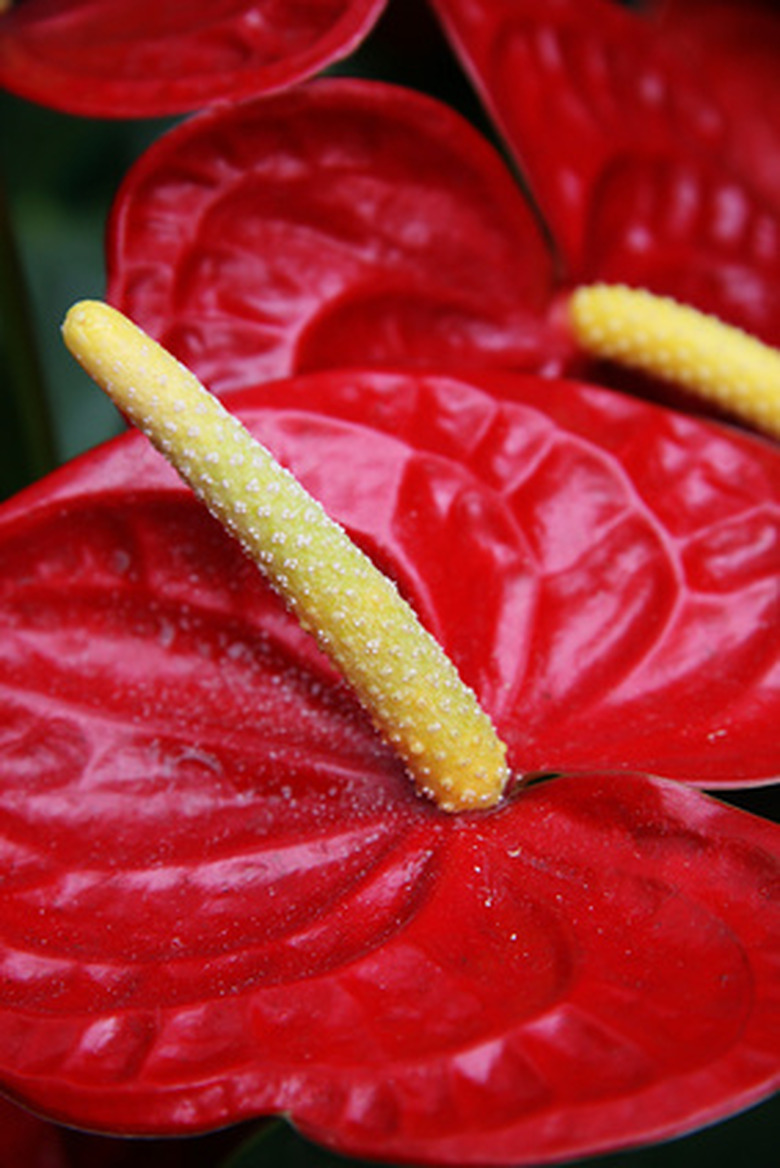How To Propagate Anthurium
Things Needed
- Pruning shears
- 4-inch pot
- Potting mix
- 8-inch wooden skewer
- Spray bottle
- Waterproof tray
- Fine gravel
Once you have seen the impossible flowers of the anthurium plant, you won't forget their almost plastic texture, their heart-shaped form and their brilliant shades of red, orange and pink. Anthuriums, also called flamingo flower, are natives of South American rain forests. They live in the moist, deeply shaded understory, on porous, infertile soils, with constant humidity. These lovely plants can be quite hardy when their basic needs are met. Hybrid anthuriums rarely produce seed, and are most often propagated by offsets, which they produce freely. By choosing the right potting mix, and maintaining high humidity, you can propagate your own anthuriums from developing offsets.
Step 1
Look for a developing offshoot near the outside of the crown of a mature anthurium. Choose an offshoot that has rootlets which are at least 1/2-inch to 1-inch long. Separate the offshoot from the base of the parent plant with pruning shears or a sharp knife.
- Once you have seen the impossible flowers of the anthurium plant, you won't forget their almost plastic texture, their heart-shaped form and their brilliant shades of red, orange and pink.
- Hybrid anthuriums rarely produce seed, and are most often propagated by offsets, which they produce freely.
Step 2
Fill a 4-inch pot with rich, well-drained potting mix. Use a quality mixture with peat moss and perlite, which will retain moisture but not become waterlogged.
Step 3
Bury the bottom inch of the offshoot in the potting mix and then firm the soil with your hands.
Step 4
Stick an 8-inch wooden skewer down into the potting mix next to the offshoot, carefully avoiding the roots. Attach the offshoot to the skewer loosely with a long metal twist tie, like the ones used for produce.
Step 5
Fill the pot with water until it drains out the bottom, and then refill the pot once more. Monitor the pot carefully and keep the soil constantly moist.
- Fill a 4-inch pot with rich, well-drained potting mix.
- Stick an 8-inch wooden skewer down into the potting mix next to the offshoot, carefully avoiding the roots.
Step 6
Fill a shallow, waterproof tray about 1 inch deep, such as an old baking sheet, with fine gravel. Use coarse aquarium gravel from a pet shop or fine pea gravel at your garden center. Fill the tray with water just below the top of the gravel, and then set the pot with the newly planted offshoot on top of the tray. Refill the tray with water as necessary to keep the level just below the surface of the gravel.
Step 7
Place the pot and tray in filtered light, but keep your plant out of direct sun.
Step 8
Mist your anthurium plant with water from a spray bottle each day in the morning hours. Mist twice a day when humidity is very low.
- Fill a shallow, waterproof tray about 1 inch deep, such as an old baking sheet, with fine gravel.
- Place the pot and tray in filtered light, but keep your plant out of direct sun.
Step 9
Feed your anthurium with a balanced liquid plant food diluted to half the recommended strength, when the plant has developed at least one new, completely unfurled leaf. Continue to feed your plant food diluted to half strength, once every month.
Tip
Do not overfeed your anthurium plant because fertilizers can easily burn their tender foliage. Keep your anthurium in filtered light indoors, and complete shade outdoors. Never expose the plant to direct sun, or the leaves will burn. Consider using filtered or distilled water to water your plant to avoid salt buildup from chlorinated tap water. Experiment with the many colors and varieties of anthiuriums, including "Obake" and "Butterfly" types.
References
- National Library and Information System Authority of Trinidad and Tobago:How to Cultivate Anthuriums
- "A Tropical Garden Flora"; George Staples and Derral Herbst; 2005
